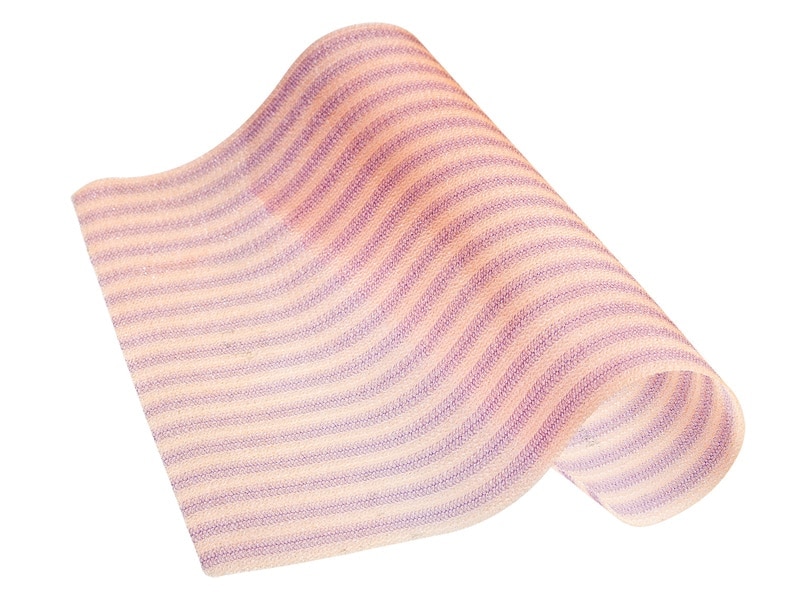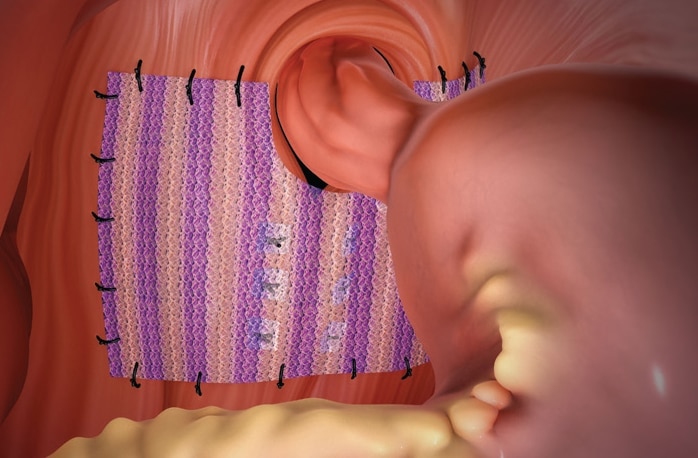


- Overview
- Products & Accessories
- EIFU & Resources
Phasix™ ST Mesh combines two market-leading technologies into one product: monofilament resorbable Phasix™ Mesh and a proven hydrogel barrier based on Sepra® technology. While the monofilament mesh supports functional healing and a strong repair, the hydrogel barrier minimizes tissue attachment to the visceral side of the mesh for intraabdominal placement.1
These meshes are available in different shapes, such as round, rectangle, and square.
For high-risk/comorbid patients, surgeons have had to choose between permanent synthetic meshes and biologic grafts—and their inherent pros and cons. Synthetic meshes can have complications that lead to mesh removal or reoperation, while biologic grafts can have accelerated degradation in the presence of bacteria which may lead to mesh failure.
Phasix™ ST Mesh handles, sutures and fixates like a synthetic mesh, while exhibiting the remodeling characteristics of a biologic mesh. It facilitates trocar deployment during laparoscopic placement.
The ST hydrogel barrier
- Minimizes risk of tissue attachment
- Has over 10 years of clinical application
- Resorbs in 30 days
- 15 clinical studies
The Phasix™ ST Mesh is a biologically derived scaffold with a hydrogel barrier for intraabdominal placement. It has been designed to provide the repair strength of a synthetic mesh and the remodeling characteristics of a biologic.
The Phasix™ ST Mesh does the following:
- Handles, sutures and fixates like a synthetic mesh
- Facilitates trocar deployment during laparoscopic placement
- Its longitudinal stripes aid with orientation and visibility during placement
MATERIAL STRUCTURE1
Monofilament mesh designs have been shown more biocompatible and less susceptible to bacterial adherence and colonization.
REPAIRS HERNIAS1
The open monofilament mesh structure provides early integration and repair strength.1
REMODELS ISSUES OVER TIME1
Vascular integration and incorporation continues, with abundant mature collagen at 52 weeks. Gradually transfers load to native tissue over time.1
VERSATILE TECGNIQUES1
Phasix™ ST Mesh may be placed in either an intraabdominal or preperitoneal position after primary hernia defect closure. Primary hernia defect closure should be achieved prior to placing the mesh.
HERNIA DEFECT CLOSURE
Hernia defect closure can be achieved through an open or minimally invasive approach (i.e., laparoscopic, robotic). Recent studies suggest potential advantages of defect closure include:
• Decreased “dead” space, which can reduce the risk of postoperative seromas
• May contribute to restoration of a functional abdominal wall
• May reduce postoperative bulging at the hernia defect site
PROMISING RESULTS IN THE PRESENCE OF BACTERIA
Phasix™ ST Mesh has not been shown to break down in the presence of bacteria—maintaining 100% of its strength at 56 days —unlike biologic grafts which demonstrate accelerated degradation in the presence of bacteria.
As shown in the graphic below, there was no presence of bacterial colonization observed in Phasix™ Mesh or Phasix™ ST Mesh 7 days post-inoculation in preclinical testing. The other side of this graph shows the presence of abscess (white material) observed SurgiMend® , Strattice™, Bio - A®, and OviTex™. Other observed indications of bacterial colonization included swelling, presence of fluids, and thickened capsule tissue.
1. Deeken CR, Matthews BD. “Characterization of the mechanical strength, resorption properties, and histologic characteristics of a fully absorbable material (Poly-4-hydroxybutyrate-Phasix™ Mesh) in a porcine model of hernia repair.” ISRN Surgery 2013; 1-12. RPT3807332.
2. DeMeester, Steven R, et al. Combination of surgical technique and bioresorbable mesh reinforcement of the crural repair leads to low early hernia recurrence rates with laparoscopic paraesophageal hernia repair. J Gastrointest Surg. 2020
Indications
Phasix™ ST Mesh is indicated for use in the reinforcement of soft tissue, where weakness exists, in procedures involving soft tissue repair, such as for the repair of hernias, including hiatal hernias.
Contraindications
Because Phasix™ ST Mesh is fully resorbable, it should not be used in repairs where permanent wound or organ support from the mesh is required.
Warnings
Device manufacture involves exposure to tetracycline hydrochloride and kanamycin sulfate. The safety and product use for patients with hypersensitivities to these antibiotics is unknown. Use of this device in patients with known allergies to tetracycline hydrochloride or kanamycin sulfate should be avoided.
Ensure proper orientation; the coated side of the prosthesis should be oriented against the bowel or sensitive organs.
Do not place the uncoated mesh side against the bowel. There is a risk for adhesion formation or erosions when the uncoated mesh side is placed in direct contact with the bowel or viscera. (Reference Surface Orientation section.)
The safety and effectiveness of Phasix™ ST Mesh in bridging repairs has not been evaluated or established. The use of any synthetic mesh or patch in a contaminated or infected wound could lead to fistula formation and/or extrusion of the mesh and it is not recommended.
If an infection develops, treat the infection aggressively. Consideration should be given regarding the need to remove the mesh. An unresolved infection may require removal of the mesh.
For hiatal hernia repair, the use of Phasix™ ST Mesh circumferentially around the esophagus is not recommended.
For hiatal hernia repair, the use of Phasix™ ST Mesh to bridge the hiatus is not recommended.
The safety and effectiveness of Phasix™ ST Mesh in the following applications has not been evaluated or established: Pregnant women, Pediatric use, Neural and Cardiovascular tissue.
Precautions
The safety and effectiveness of Phasix™ ST Mesh has not been evaluated in the presence of malignancies in the abdominopelvic cavity.
Adverse Reactions
In preclinical testing, Phasix™ ST Mesh elicited a minimal tissue reaction characteristic of foreign body response to a substance. The tissue reaction resolved as the mesh was resorbed. Possible complications may include, but are not limited to, seroma, adhesion, hematoma, pain, infection, inflammation, allergic reaction, hemorrhage, extrusion, erosion, migration, fistula formation, and recurrence of the hernia or soft tissue defect. Possible complications in hiatal hernia repair may include esophageal erosion and dysphagia related to crural fibrosis.
Please consult package insert for more detailed safety information and instructions for use.
BD-76012
1. Deeken CR, Matthews BD. “Characterization of the mechanical strength, resorption properties, and histologic characteristics of a fully absorbable material (Poly-4-hydroxybutyrate-Phasix™ Mesh) in a porcine model of hernia repair.” ISRN Surgery 2013; 1-12. RPT3807332.
2. DeMeester, Steven R, et al. Combination of surgical technique and bioresorbable mesh reinforcement of the crural repair leads to low early hernia recurrence rates with laparoscopic paraesophageal hernia repair. J Gastrointest Surg. 2020
Indications
Phasix™ ST Mesh is indicated for use in the reinforcement of soft tissue, where weakness exists, in procedures involving soft tissue repair, such as for the repair of hernias, including hiatal hernias.
Contraindications
Because Phasix™ ST Mesh is fully resorbable, it should not be used in repairs where permanent wound or organ support from the mesh is required.
Warnings
Device manufacture involves exposure to tetracycline hydrochloride and kanamycin sulfate. The safety and product use for patients with hypersensitivities to these antibiotics is unknown. Use of this device in patients with known allergies to tetracycline hydrochloride or kanamycin sulfate should be avoided.
Ensure proper orientation; the coated side of the prosthesis should be oriented against the bowel or sensitive organs.
Do not place the uncoated mesh side against the bowel. There is a risk for adhesion formation or erosions when the uncoated mesh side is placed in direct contact with the bowel or viscera. (Reference Surface Orientation section.)
The safety and effectiveness of Phasix™ ST Mesh in bridging repairs has not been evaluated or established. The use of any synthetic mesh or patch in a contaminated or infected wound could lead to fistula formation and/or extrusion of the mesh and it is not recommended.
If an infection develops, treat the infection aggressively. Consideration should be given regarding the need to remove the mesh. An unresolved infection may require removal of the mesh.
For hiatal hernia repair, the use of Phasix™ ST Mesh circumferentially around the esophagus is not recommended.
For hiatal hernia repair, the use of Phasix™ ST Mesh to bridge the hiatus is not recommended.
The safety and effectiveness of Phasix™ ST Mesh in the following applications has not been evaluated or established: Pregnant women, Pediatric use, Neural and Cardiovascular tissue.
Precautions
The safety and effectiveness of Phasix™ ST Mesh has not been evaluated in the presence of malignancies in the abdominopelvic cavity.
Adverse Reactions
In preclinical testing, Phasix™ ST Mesh elicited a minimal tissue reaction characteristic of foreign body response to a substance. The tissue reaction resolved as the mesh was resorbed. Possible complications may include, but are not limited to, seroma, adhesion, hematoma, pain, infection, inflammation, allergic reaction, hemorrhage, extrusion, erosion, migration, fistula formation, and recurrence of the hernia or soft tissue defect. Possible complications in hiatal hernia repair may include esophageal erosion and dysphagia related to crural fibrosis.
Please consult package insert for more detailed safety information and instructions for use.
BD offers training resources to help improve your clinical practices as part of our goal of advancing the world of health.
BD supports the healthcare industry with market-leading products and services that aim to improve care while lowering costs. We host and take part in events that excel in advancing the world of health™.
1. Deeken CR, Matthews BD. “Characterization of the mechanical strength, resorption properties, and histologic characteristics of a fully absorbable material (Poly-4-hydroxybutyrate-Phasix™ Mesh) in a porcine model of hernia repair.” ISRN Surgery 2013; 1-12. RPT3807332.
2. DeMeester, Steven R, et al. Combination of surgical technique and bioresorbable mesh reinforcement of the crural repair leads to low early hernia recurrence rates with laparoscopic paraesophageal hernia repair. J Gastrointest Surg. 2020
Indications
Phasix™ ST Mesh is indicated for use in the reinforcement of soft tissue, where weakness exists, in procedures involving soft tissue repair, such as for the repair of hernias, including hiatal hernias.
Contraindications
Because Phasix™ ST Mesh is fully resorbable, it should not be used in repairs where permanent wound or organ support from the mesh is required.
Warnings
Device manufacture involves exposure to tetracycline hydrochloride and kanamycin sulfate. The safety and product use for patients with hypersensitivities to these antibiotics is unknown. Use of this device in patients with known allergies to tetracycline hydrochloride or kanamycin sulfate should be avoided.
Ensure proper orientation; the coated side of the prosthesis should be oriented against the bowel or sensitive organs.
Do not place the uncoated mesh side against the bowel. There is a risk for adhesion formation or erosions when the uncoated mesh side is placed in direct contact with the bowel or viscera. (Reference Surface Orientation section.)
The safety and effectiveness of Phasix™ ST Mesh in bridging repairs has not been evaluated or established. The use of any synthetic mesh or patch in a contaminated or infected wound could lead to fistula formation and/or extrusion of the mesh and it is not recommended.
If an infection develops, treat the infection aggressively. Consideration should be given regarding the need to remove the mesh. An unresolved infection may require removal of the mesh.
For hiatal hernia repair, the use of Phasix™ ST Mesh circumferentially around the esophagus is not recommended.
For hiatal hernia repair, the use of Phasix™ ST Mesh to bridge the hiatus is not recommended.
The safety and effectiveness of Phasix™ ST Mesh in the following applications has not been evaluated or established: Pregnant women, Pediatric use, Neural and Cardiovascular tissue.
Precautions
The safety and effectiveness of Phasix™ ST Mesh has not been evaluated in the presence of malignancies in the abdominopelvic cavity.
Adverse Reactions
In preclinical testing, Phasix™ ST Mesh elicited a minimal tissue reaction characteristic of foreign body response to a substance. The tissue reaction resolved as the mesh was resorbed. Possible complications may include, but are not limited to, seroma, adhesion, hematoma, pain, infection, inflammation, allergic reaction, hemorrhage, extrusion, erosion, migration, fistula formation, and recurrence of the hernia or soft tissue defect. Possible complications in hiatal hernia repair may include esophageal erosion and dysphagia related to crural fibrosis.
Please consult package insert for more detailed safety information and instructions for use.